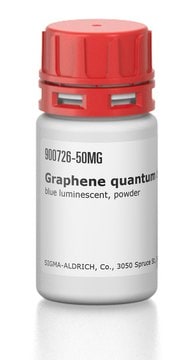Kluczowe dokumenty
776793
InP/ZnS quantum dots
stabilized with oleylamine ligands, fluorescence λem 560 nm, 5 mg/mL in toluene
Synonim(y):
Cadmium free core shell quantum dots, Cadmium free quantum dots, Core/Shell heavy metal free quantum dots, Fluorescent nanocrystals
About This Item
Polecane produkty
Poziom jakości
Formularz
liquid
stężenie
5 mg/mL in toluene
fluorescencja
FWHM <85 nm, quantum yield ~25%
λem 560 nm
temp. przechowywania
2-8°C
Szukasz podobnych produktów? Odwiedź Przewodnik dotyczący porównywania produktów
Powiązane kategorie
Zastosowanie
and the corresponding regulations worldwide makes these InP/ZnS quantum dots as more desirable alternatives for consumer applications.
Inne uwagi
Hasło ostrzegawcze
Danger
Zwroty wskazujące rodzaj zagrożenia
Zwroty wskazujące środki ostrożności
Klasyfikacja zagrożeń
Aquatic Chronic 3 - Asp. Tox. 1 - Carc. 1B - Flam. Liq. 2 - Repr. 2 - Skin Irrit. 2 - STOT RE 1 - STOT RE 2 - STOT SE 3
Organy docelowe
Central nervous system, Lungs, Respiratory system
Klasa zagrożenia wodnego (WGK)
WGK 3
Temperatura zapłonu (°F)
closed cup
Temperatura zapłonu (°C)
closed cup
Wykazy regulacyjne
Wykazy regulacyjne dotyczą głównie produktów chemicznych. Można w nich podawać ograniczoną liczbę informacji na temat produktów niechemicznych. Brak wpisu oznacza, że żaden ze składników nie znajduje się w wykazie. Użytkownik odpowiada za zagwarantowanie bezpiecznego i zgodnego z prawem stosowania produktu.
EU REACH Annex XVII (Restriction List)
Wybierz jedną z najnowszych wersji:
Masz już ten produkt?
Dokumenty związane z niedawno zakupionymi produktami zostały zamieszczone w Bibliotece dokumentów.
Produkty
Since the first report of the low-cost dye-sensitized solar cell (DSSC) in 1991 by Gratzel and his coworker,1 dye-sensitized solar cells (DSSC) has been regarded as one of the most promising photovoltaic technologies because of their transparent and colorful characteristics, as well as low cost.
Professor Sharma and colleagues review the synthesis and applications of this novel material. This includes a discussion of the unique properties of quantum dots and their suitability for solar cell applications, along with common synthesis techniques used to develop these materials.
Professor Xiaohu Gao (University of Washington, USA) provides a overview of recent quantum dot (QD) advancements and their potential for advancing bioassay and bioimaging technologies.
The past several decades have seen major advancements in the synthesis of metal nanomaterials. Most recently, controlled synthesis has become versatile enough to regulate the exact number of atoms and ligands of very small metal nanoparticles, referred to as “clusters”.
Global Trade Item Number
| SKU | GTIN |
|---|---|
| 776793-5ML | 4061837645761 |
Nasz zespół naukowców ma doświadczenie we wszystkich obszarach badań, w tym w naukach przyrodniczych, materiałoznawstwie, syntezie chemicznej, chromatografii, analityce i wielu innych dziedzinach.
Skontaktuj się z zespołem ds. pomocy technicznej






